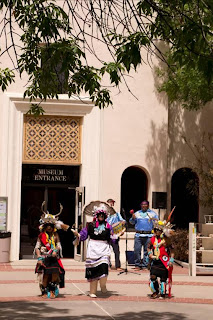Welcome to Las Cruces, New Mexico! I recently graduated from the Museum Conservation Program at New Mexico State University in Las Cruces, New Mexico. I am so grateful to have had the experience the program offers and am happy to have the opportunity to present the program to other emerging conservators.
Basically, the program’s requirements are the same as conservation graduate school requirements. Some of the classes can be taken as graduate level classes, but the program is primarily an undergraduate program. Silvia Marinas, the Head of the Museum Conservation Department and a private Conservator herself, engineered the program to fulfill all of the graduate school requirements. This means that you take Art History, Studio Art, Archaeology, Entomology, Museum Studies and Chemistry. In addition, there are four core classes. One of the classes teaches the basics of Collections Care & Management, skills that you later put into practice in an internship with the New Mexico State University Museum. In two other classes, titled Museum Conservation Techniques, you learn the basic restoration techniques for ceramics, paintings on canvas and paintings on metal. Then you put those skills to work on other, real, objects in an Internship class with Silvia Marinas.
Overall, the program is structured to be useful in real life. The format in which Silvia Marinas teaches the classes is particularly useful, because she has us create materials that will be useful for us in the future. For instance, from her Collections Care class I have a binder with information on things such as temperature & humidity guidelines, handling, storage, etc., for each kind of museum object. From her Museum Conservation Techniques classes I have condition reports that I created of various types of objects that I can and have referenced when working on similar objects. And overall, the program is structured to fulfill the requirements for graduate schools and Pre-grad internships, so students are well prepared to apply to these places.
Reconstructed Ceramic Vessel from Museum Conservation Techniques Class
The best part of Las Cruces is the people. Las Cruces is primarily a college town but the professors make every effort to let us know what exhibitions, shows or lectures we should attend. There are many cultural events related to the strong Hispanic & American Indian heritage in the area, such as American Indian Week (pictured). The community is tight-knit and friendly. There are farmers’ markets, gallery walks and museumsto explore as well as hiking and outdoor recreation (Las Cruces gets over 350 days of sunshine a year) and great Mexican food.
I would be happy to try and answer questions for other emerging conservators! Here is the link to the Program’s website: http://artdepartment.nmsu.edu/programs/museumcons/index.php?go=home.html





